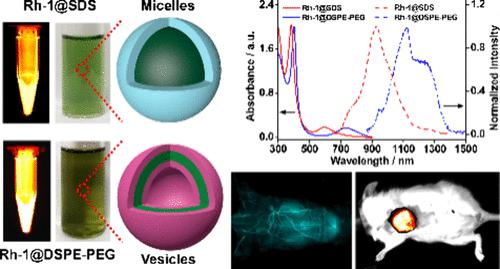纳米铑(I)基金属有机骨架在生物成像中显示出强烈的NIR-II发光
IF 9.1
1区 材料科学
Q1 CHEMISTRY, MULTIDISCIPLINARY
引用次数: 0
摘要
虽然发光金属有机框架(mof)已经被广泛报道,但很少发现在第二近红外(NIR-II, 1000-1700 nm)窗口发射的例子。在这项工作中,两个纳米级铑(I)基mof (Rh-1@SDS和Rh-1@DSPE-PEG)在十二烷基硫酸钠(SDS)和1,2-二硬脂酰-sn-甘油-3-磷酸乙醇胺- n-甲氧基聚乙二醇(DSPE-PEG)的水分散体中被可控地构建,其中胶束和囊泡状聚集体分别形成,具有高胶体稳定性。Rh-1@DSPE-PEG的囊状分散体在1125(1245,肩)nm处表现出强烈的NIR-II发光。因此,该纳米omof被用作NIR-II发光探针,显示高分辨率的全身和局部血管成像,清晰地显示皮瓣移植术后恢复过程。同时,在NIR-II窗口也显示出优越的肿瘤靶向性。据我们所知,这项研究代表了具有强烈NIR-II发光和出色成像能力的纳米omofs的第一个例子。本文章由计算机程序翻译,如有差异,请以英文原文为准。

Nanoscale Rhodium(I) Based Metal–Organic Framework Demonstrating Intense NIR-II Luminescence for Bioimaging
Although luminescent metal–organic frameworks (MOFs) have been widely reported, rare examples were found to emit in the second near-infrared (NIR-II, 1000–1700 nm) window. In this work, two nanoscale rhodium(I)-based MOFs (Rh-1@SDS and Rh-1@DSPE-PEG) have been controllably constructed in the aqueous dispersions of sodium dodecyl sulfate (SDS) and 1,2-distearoyl-sn-glycero-3-phosphoethanolamine-N-methoxy-poly(ethylene glycol) (DSPE-PEG), wherein micelle- and vesicle-like aggregates form, respectively, with high colloidal stability. The vesicular dispersion of Rh-1@DSPE-PEG exhibits intense NIR-II luminescence at 1125 (1245, shoulder) nm. Consequently, this nanoMOF was used as an NIR-II luminescence probe, indicative of high-resolution systemic and local vascular imaging, where the postoperative recovery process of flap transplantation was clearly visualized. Meanwhile, it also demonstrates superior tumor targeting in the NIR-II window. To the best of our knowledge, this research represents the first example of nanoMOFs having intense NIR-II luminescence and excellent imaging capabilities.
求助全文
通过发布文献求助,成功后即可免费获取论文全文。
去求助
来源期刊

Nano Letters
工程技术-材料科学:综合
CiteScore
16.80
自引率
2.80%
发文量
1182
审稿时长
1.4 months
期刊介绍:
Nano Letters serves as a dynamic platform for promptly disseminating original results in fundamental, applied, and emerging research across all facets of nanoscience and nanotechnology. A pivotal criterion for inclusion within Nano Letters is the convergence of at least two different areas or disciplines, ensuring a rich interdisciplinary scope. The journal is dedicated to fostering exploration in diverse areas, including:
- Experimental and theoretical findings on physical, chemical, and biological phenomena at the nanoscale
- Synthesis, characterization, and processing of organic, inorganic, polymer, and hybrid nanomaterials through physical, chemical, and biological methodologies
- Modeling and simulation of synthetic, assembly, and interaction processes
- Realization of integrated nanostructures and nano-engineered devices exhibiting advanced performance
- Applications of nanoscale materials in living and environmental systems
Nano Letters is committed to advancing and showcasing groundbreaking research that intersects various domains, fostering innovation and collaboration in the ever-evolving field of nanoscience and nanotechnology.
 求助内容:
求助内容: 应助结果提醒方式:
应助结果提醒方式:


